Myth: The availability of guns causes crime
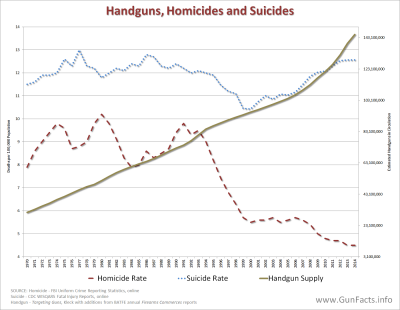 |
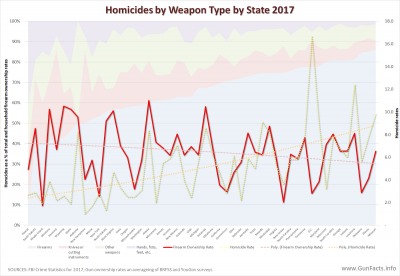 |
Fact: Though the number of firearms owned by private citizens has been increasing steadily since 1970, the overall rate of homicides and suicides has not risen (though suicide rates did start to rise during the Great Recession). 1 As the chart shows, there is no correlation between the availability of firearms and the rates of homicide and suicide in America.
Fact: Internationally speaking “There’s no clear relationship between more guns and higher levels of violence.” 2
Fact: When homicide modes (weapon type) are charted against gun ownership rates and total homicide rates, homicides rise as per capita gun ownership rates decline.
Fact: “A detailed study of the major surveys completed in the past 20 years or more provides no evidence of any relationship between the total number of legally held firearms in society and the rate of armed crime. Nor is there a relationship between the severity of controls imposed in various countries or the mass of bureaucracy involved with many control systems with the apparent ease of access to firearms by criminals and terrorists.” 3
Fact: Handgun ownership among groups normally associated with higher violent crime (young males, blacks, low income, inner city, etc.) is at or below national averages. 4
Fact: Among inmates who used a firearm in the commission of a crime, the most significant correlations occurred when the inmates’ parents abused drugs (27.5%) and when inmates had friends engaged in illegal activities (32.5% for robberies, 24.3% for drug trafficking). 5
Fact: Five out of six gun-possessing felons obtained handguns from the secondary market and by theft, and “[the] criminal handgun market is overwhelmingly dominated by informal transactions and theft as mechanisms of supply.” 6
Fact: The majority of handguns in the possession of criminals are stolen, and not necessarily by the criminals in question. 7 In fact, over 100,000 firearms are stolen in burglaries every year, and most of them likely enter the criminal market (i.e., are sold or traded to criminals). 8
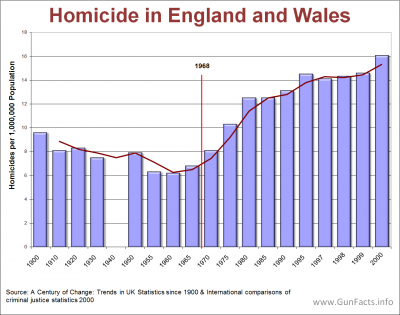 Fact: In 1968, the U.K. passed laws that reduced the number of licensed firearm owners, and thus reduced firearm availability. U.K. homicide rates have steadily risen since then. 9 Ironically, firearm use in crimes has doubled in the decade after the U.K. banned handguns. 10
Fact: In 1968, the U.K. passed laws that reduced the number of licensed firearm owners, and thus reduced firearm availability. U.K. homicide rates have steadily risen since then. 9 Ironically, firearm use in crimes has doubled in the decade after the U.K. banned handguns. 10
Fact: Most violent crime is caused by a small minority of repeat offenders. One California study found that 3.8% of a group of males born in 1956 were responsible for 55.5% of all serious felonies. 11 75-80% of murder arrestees have prior arrests for a violent (including non-fatal) felony or burglary. On average, they have about four felony arrests and one felony conviction.
Fact: Half of all murders are committed by people on “conditional release” (i.e., parole or probation). 12 81% of all homicide defendants had an arrest record, 67% had a felony arrest record, 70% had a conviction record, and 54% had a felony conviction. 13
Fact: Per capita firearm ownership rates have risen steadily since 1959 while crime rates have gone up and down depending on economics, drug trafficking innovations, and “get tough” crime legislation. 14
Thoughts: Criminals are not motivated by guns. They are motivated by opportunity. Attempts to reduce public access to firearms provide criminals more points of opportunity. It is little wonder that high-crime cities also tend to be those with the most restrictive gun control laws – which criminals tend to ignore.
Myth: Gun availability increases suicide rates
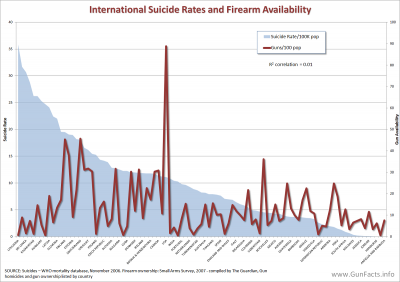 |
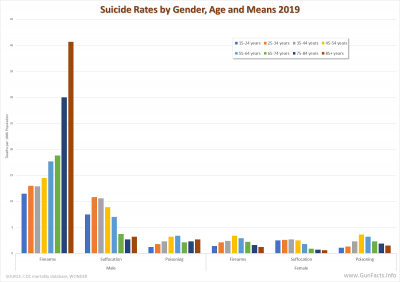 |
Fact: Cross national studies show that there is no relationship to suicides rates and the availability of firearms. Two outstanding contrasts:
- The U.S. and Canada – who share geography, cultural elements, and entertainment – have nearly identical suicide rates, but Canada has significantly lower gun ownership.
- Lithuania – which has nearly zero gun ownership – has the world’s highest suicide rate, more than three times that of the United States.
Fact: Firearm use in suicides is heavily skewed to older males, especially older rural, white males. This despite firearms being readily available to all adults and all genders.
Myth: Gun availability is what is causing school shootings
Fact: Schoolyard shootings have been occurring since at least 1974, so it is not a new phenomenon due to increases in gun ownership. 15
Fact: More than 50% of these murderers started thinking about their assaults two or more weeks before the shooting, and 75% planned-out their attacks, showing that these events are not spontaneous. 16
Thoughts: In rural areas, guns are everywhere, and children are taught to shoot at young ages – yet these areas are almost devoid of schoolyard shootings. Clearly, availability is not the issue.
Myth: Gun availability leads to massacres
Fact: In 62% of mass public shootings, the assailant had a history of having “displayed signs of mental health problems prior to the killings.” 17
Myth: Gun ownership is linked to higher homicide rates
Fact: This “study” 18 has multiple defects which, when corrected, reverse the results. Some of the defects of this study include:
- Exclusion of the District of Columbia, a high crime city
- Use of other crime rates to indirectly explain homicide rates
- Use of purely cross-sectional data that never allowed control variable analysis
- Data from different years is used without any explanation (unemployment rate from 2000 to explain the homicide rate from 2001 to 2003, etc.).
Myth: Handguns are 43 times more likely to kill a family member than a criminal
Fact: Of the 43 deaths reported in this flawed study, 37 (86%) were suicides. Other deaths involved criminal activity between the family members (botched drug deals). 19
Fact: Of the remaining deaths, the deceased family members include felons, drug dealers, violent spouses committing assault, and other criminals. 20
Fact: Only 0.1% of the defensive uses of guns results in the death of the predator. 21 This means you are much more likely to prevent a crime without bloodshed than hurt a family member.
Notes:
- Targeting Guns: Firearms and Their Control, Gary Kleck, Aldine de Gruyter, 1997. (With supporting data from the FBI Uniform Crime Statistics, 1972 to 1995.) ↩
- Small Arms Survey Project, Keith Krause, Graduate Institute of International Studies, Geneva, 2007 ↩
- Minutes of Evidence, Colin Greenwood, Select Committee on Northern Ireland Affairs, January 29, 2003 ↩
- Targeting Guns: Firearms and Their Control, Gary Kleck, Aldine de Gruyter, 1997. (Ownership tables derived from the annual “General Social Survey.”) ↩
- Firearm Use by Offenders, Bureau of Justice Statistics, November 2001 ↩
- The Armed Criminal in America: A Survey of Incarcerated Felons, James D. Wright, Peter H. Rossi, National Institute of Justice (U.S.), 1985 ↩
- Targeting Guns: Firearms and Their Control, Gary Kleck, Aldine de Gruyter, 1997. ↩
- Victimization During Household Burglary, Bureau of Justice Statistics, September 2010 ↩
- A Century of Change: Trends in UK Statistics since 1900, Hicks, Joe; Allen, Grahame (SGS), Social and General Statistics Section, House of Commons ↩
- Weapons sell for just £50 as suspects and victims grow ever younger, The Times, August 24, 2007 ↩
- The Prevalence and Incidence of Arrest Among Adult Males in California, Robert Tillman, prepared for California Department of Justice, Bureau of Criminal Statistics and Special Services, Sacramento, California, 1987 ↩
- Probation and Parole Violators in State Prison, 1991: Survey of State Prison Inmates, Robyn Cohen, U.S. Dept. of Justice, Office of Justice Programs, Bureau of Justice Statistics, 1995 ↩
- Felony Defendants in Large Urban Counties, 1998, Brian Reaves, U.S. Department of Justice, Office of Justice Programs, Bureau of Justice Statistics, November 2001 ↩
- Felony Defendants in Large Urban Counties, 1998, Brian Reaves, U.S. Department of Justice, Office of Justice Programs, Bureau of Justice Statistics, November 2001 (Based on a compilation of 85 separate surveys from 1959 through 1996.) ↩
- U.S.S.S. Safe School Initiative: An Interim Report on the Prevention of Targeted Violence in Schools, B. Vossekuil, M. Reddy, R. Fein, R. Borum, W. Modzeleski, U. S. Secret Service, Threat Assessment Center, 2000 ↩
- U.S.S.S. Safe School Initiative: An Interim Report on the Prevention of Targeted Violence in Schools, B. Vossekuil, M. Reddy, R. Fein, R. Borum, W. Modzeleski, U. S. Secret Service, Threat Assessment Center, 2000 ↩
- Mass Shootings: Maybe What We Need Is a Better Mental-Health Policy, Mother Jones, November 9, 2012 ↩
- State-level homicide victimization rates in the US in relation to survey measures of household firearm ownership, 2001–2003, Matthew Miller, David Hemenway, Deborah Azrael, Harvard School of Public Health, October 27, 2006 ↩
- Protection or Peril? An Analysis of Firearm-Related Deaths in the Home, Arthur L. Kellerman, D.T. Reay, 314 New Eng. J. Med. 1557-60, June 12, 1986. (Kellerman admits that his study did “not include cases in which burglars or intruders are wounded or frightened away by the use or display of a firearm.” He also admitted his study did not look at situations in which intruders “purposely avoided a home known to be armed.” This is a classic case of a “study” conducted to achieve a desired result. In his critique of this “study”, Gary Kleck notes that the estimation of gun ownership rates was “inaccurate”, and that the total population came from a non-random selection of only two cities ) ↩
- Protection or Peril? An Analysis of Firearm-Related Deaths in the Home, Arthur L. Kellerman, D.T. Reay, 314 New Eng. J. Med. 1557-60, June 12, 1986 ↩
- Point Blank: Guns and Violence in America, Gary Kleck, New York: Aldine de Gruyter, 1991 ↩
